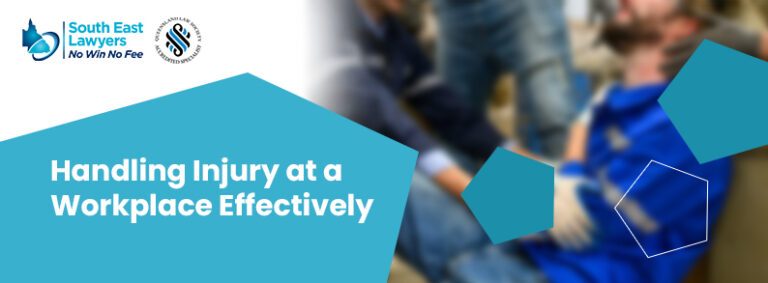Ever thrown your back out lifting boxes, or tripped on a stray cable at the office? If so, you’re probably one the 497,300 Australian workers who got injured or sick due to work in 2021-2022.
In the latest statistics on work-related injuries in Australia by the Australian Bureau of Statistics, 3.5% of the Australian labour force experienced work-related injuries in 2021-2022. But here’s the shocker: a large number didn’t receive workers’ compensation or any form of financial help. Are you one of them as well?
Dive into our analysis of the study to see if your job is high-risk, what the most common injuries are, and why getting legal help might be crucial, even for seemingly minor injuries. Keep reading to find out the state of workplace injuries in Australia and how you and South East Injury Lawyers can help improve it.
Key Takeaways:
- Although the numbers are still significantly high, work injuries are down in Australia (3.5% in 2021-2022) and more injured workers are getting compensated (31%).
- Unfortunately, many injured workers (over 60%) still miss out on workers’ compensation.
- A significant portion of injuries might go unreported due to fear of being fired by the boss or lack of awareness.
- Certain jobs carry a higher risk of injury, including community service workers, machinery operators, and labourers.
Work-related injuries and illnesses were relatively common in Australian workplaces in 2021-2022, affecting 3.5% of workers. That’s around 497,300 workers who have gotten in an accident at work that resulted in injuries or illnesses.
Although that number is still significantly high, the workplace injury rate in Australia has seen a steady decline over the past few years, which is great news for the country’s labour force. The number of workers who had a workplace injury or illness in Australia decreased from 6.4% in 2005-2006 to 3.5% in 2021-2022. Just look at the table below.
| Year | Total Workplace Injury Rate (%) |
| 2005-06 | 6.4 |
| 2009-10 | 5.3 |
| 2013-14 | 4.3 |
| 2017-18 | 4.2 |
| 2021-22 | 3.5 |
Some possible contributing factors that may have caused this decline in workplace injury rates are:
- Growing emphasis on workplace safety regulations and practices over the years. This could involve stricter guidelines, improved training for workers and employers, and better injury reporting systems.
- Advancements in technology and automation might have reduced the need for manual labour which often carries a higher risk of injuries.
Another piece of good news is that the Australian Bureau of Statistics study showed that more Australian workers who have gotten in a work accident were compensated in 2021-2022 compared to the years prior.
In 2021-2022, about 31% or 154,163 workers who suffered from a work-related injury or illness received workers’ compensation. That’s 4% more than in 2017-2018 when only 27% of the injured working population got compensated.
These are only some of the key pieces of data that you need to know about the work-related injury rates in Australia. Now we’re diving straight into the details to give you our more comprehensive analysis of the status of workplace injuries in the country.
Who suffered from work-related injuries more: men or women?
Of the 497,300 workers who got injured at work, 58% of them were men. This shows that men are more at risk of suffering from workplace-related injuries than women because men are more likely to be employed in industries that have a higher probability of accidents and injuries.
Three of those high-risk jobs are in the top 5 occupation groups that had the highest work-related injury rate in Australia:
- Community and personal service workers
- Machinery operators and drivers
- Labourers
- Technicians and trade workers
- Sales workers
It’s important to note, however, that although more men got injured at work than women, the data shows a decrease in injury rates for both genders. See the table below.
| Year | Men (%) | Women % |
| 2005-06 | 7.4 | 5.2 |
| 2009-10 | 5.6 | 5.0 |
| 2013-14 | 4.9 | 3.6 |
| 2017-18 | 4.4 | 4.1 |
| 2021-22 | 3.9 | 3.1 |
It also shows that while men still have a higher rate, the gap between men and women seems to be closing (3.9% for males vs 3.1% for females in 2021-2022). The gap between the injury rates in men and women was cut down significantly from 2.2% to 0.8% in just five years.
When it comes to age groups, men who are 15-39 years old had the highest work-related injury rate. This is probably because a big chunk of the labour force in Australia, especially in high-risk industries, is composed of younger men.
Also, more men who experienced a work-related injury took some time off work than women who got injured or sick (67.1% of men vs 63.6% of women). This is even though women are more likely to report their work-related injury or illness than men (91.0% compared to 86.4%).
What are the most common work-related injuries in Australia?
The study indicates that the most common work-related injuries in Australia during 2021-2022 were musculoskeletal in nature. Here’s a breakdown of the top three:
Sprains, strains or dislocations
This injury category topped the list, accounting for 26.1% of all work-related injuries. These injuries can affect muscles, ligaments, and tendons, often caused by lifting, overexertion, or repetitive tasks.
Chronic joint or muscle conditions
Coming in second at 19.6%, chronic joint or muscle conditions can cover various ongoing issues like pain, stiffness, and reduced mobility. These conditions can develop over time due to repetitive strain or awkward postures at work.
Cuts or open wounds
Although less frequent than the first two, cuts or open wounds were the third most common injury type, making up 12.1% of reported cases. These injuries are often caused by sharp objects, machinery failures, or falls in the workplace.
These top three work-related injuries in 2021 – 2022 are also the top 3 most common injuries in 2017-2018, with the rate of chronic joint or muscle conditions increasing significantly from 15.8% to 19.6%.
In 2021-2022, the most common causes for these injuries are:
Lifting, pushing, pulling or bending
This action, fundamental to many jobs, was the leading cause of injuries, accounting for 23.5% of all reported cases. It can put a strain on muscles and joints, especially with improper techniques or heavy loads.
Fall on the same level (including slip or fall)
Slips, trips, and falls on the same level ranked second at 17.3%. These incidents can be caused by wet floors, uneven surfaces, or poor housekeeping in the workplace.
Hitting or being hit or cut by an object or vehicle
Accounting for 11.4%, this can happen due to various factors like operating machinery, working with moving objects, or congested work areas. It highlights the importance of proper training, clear walkways, and utilising safety gear when working with potentially hazardous equipment or materials.
Now, you may be wondering…
Where and when did all these injuries happen?
According to the same study from ABS, 91% of the reported cases or 452,543 injuries happened in the workplace, while 6% or 29,838 occurred while travelling on business, travelling to or from work, or while on lunchtime or break activities.
Other work-related injuries, on the other hand, occurred while working from home.
What kind of jobs have the highest risk of work-related injuries?
Several occupation groups in Australia face a higher risk of work-related injuries compared to others. Here’s a breakdown of the top 3 groups.
1. Community and Personal Service Workers (7.0%)
This broad category encompasses social workers, childcare workers, nurses, and other professions that involve manual handling, assisting others, or working long shifts. The physically demanding nature of these jobs and the potential for violence or aggression in some settings can contribute to a higher injury rate.
2. Machinery Operators and Drivers (6.5%)
Operating heavy machinery, forklifts, or driving vehicles for extended periods can lead to musculoskeletal injuries, fatigue, and accidents. This group’s injury rate reflects the inherent risks associated with operating mobile equipment or working in transportation environments.
3. Labourers (5.7%)
Labourers perform various physical tasks across different industries, often involving lifting, carrying, digging, or using hand tools. These physically demanding activities combined with potential time pressure or exposure to harsh weather conditions contribute to their higher injury rate.
The study also showed that some Australian industries pose a greater risk of work-related injuries compared to others. The accommodation and food services industry, for example, accounts for 5.6% of the total work-related injuries in Australia.
The physically demanding nature of jobs like lifting heavy trays of food, working long hours on your feet, and repetitive tasks can lead to a high rate of sprains, strains, and musculoskeletal issues. Additionally, slip and fall hazards in kitchens and fast-paced environments can contribute to injuries.
Contrary to that, the professional, scientific and technical services industry is probably the safest industry to work on. It accounts for only 1% of the total work-related injuries in Australia.
Workers’ Compensation in Australia (2021 -2022)
While work-related injuries and illnesses were relatively common in Australia (affecting 3.5% of workers in 2021-2022), not everyone who experienced an injury received financial compensation.
Here’s a breakdown of the figures:
- Out of the total workforce, 497,300 people experienced a work-related injury or illness during the 2021-2022 period.
- Around 153,000 workers (or 31%) received workers’ compensation
- Roughly 122,000 people did not apply for workers’ compensation
- About 8,500 workers did not apply for and did not receive workers’ compensation
Why didn’t everyone who experienced an injury receive workers’ compensation?
It’s unfortunate that not everyone who got injured or sick because of their work did not receive any form of financial assistance like workers’ compensation. Let’s look into some possible reasons why is that the case:
Eligibility Criteria
There are specific criteria a worker needs to meet to be eligible for compensation. This could include factors like being past a probationary period, the nature of the injury being directly work-related, or the injury causing a specific amount of lost time or income.
Some workers may have not met these criteria, making them ineligible for a workers’ compensation claim.
Underreporting
Let’s be honest. While the data from the ABS is as accurate as it can get, we can’t know for sure the exact numbers if they weren’t reported in the first place.
Some workers might choose not to report their injuries for various reasons:
- fear of repercussions from their employer
- lack of awareness about their rights to compensation
- simply not wanting to deal with the paperwork involved in filing a claim
Disputes
In some cases, there might be disagreements between the worker and the employer or the workers’ compensation provider about the cause or severity of the injury. This could lead to a delay or denial of compensation while the dispute is resolved.
Legal Representation
This is probably the most overlooked yet most important reason why some workers don’t get compensated at all.
Workers might need legal representation to navigate the complexities of the workers’ compensation system. This could disadvantage them in understanding their rights and filing a successful claim.
Importance of a personal injury lawyer in workers’ compensation claims
Although the number of people who did not receive financial assistance has decreased from 47% in 2017-18 to 43% in 2021-22, over 300,000 workers were still uncompensated, which is an incredibly significant number.
So if you, or someone you know, have been injured or got sick due to a work accident or because of the nature of your work, seeking help from a workers’ compensation lawyer will save you or them a whole world of trouble.
Workers’ compensation laws can be complex and navigating a claim on your own can be stressful, especially when you’re recovering from an injury. That is why speaking with a workers’ compensation lawyer is crucial in these situations even if you think that your injury or sickness is just minor.
Workers’ compensation lawyers like us here at South East Injury Lawyers can help you:
- Understand whether you have a claim or not
- Navigate workers’ compensation laws of the state you live in and let you know where you stand in your case
- Make and fight for a compensation claim on your behalf while you recover
- Maximise your settlements through skilled negotiation and representation
Overall, a workers’ compensation lawyer can increase your chances of a successful claim and ensure you receive the compensation you rightfully deserve.
Conclusion
Work-related injuries were reported by 3.5% of Australian workers in 2021-2022. Although concerning, this number reflects a positive trend as the overall injury rate has been going down in recent years. Additionally, more injured workers are receiving compensation now compared to the past.
However, there’s still work to be done because many injured workers still don’t get financial help. If you or someone you know are in this situation, seek legal advice. A qualified workers’ compensation lawyer like South East Injury Lawyer can help you navigate the claims process and ensure you receive fair compensation for your injury.
Contact us today for a no-obligation 15-minute consultation, for FREE.






